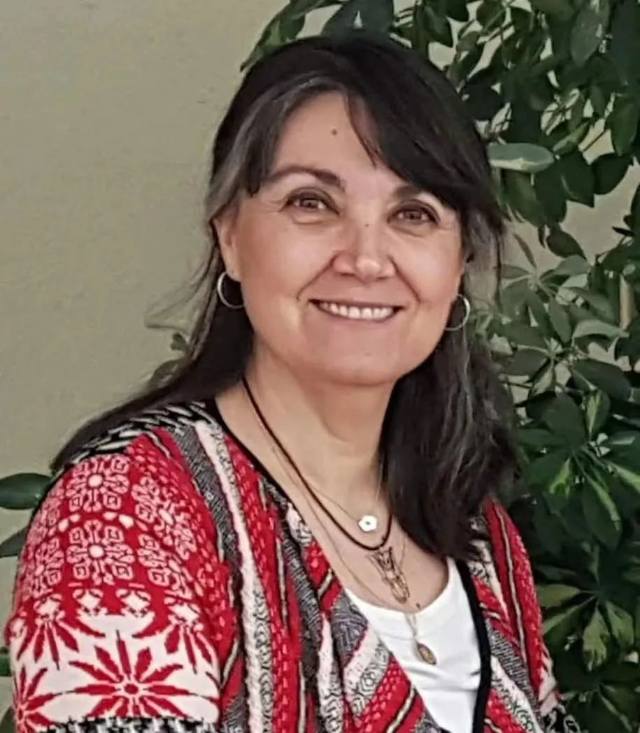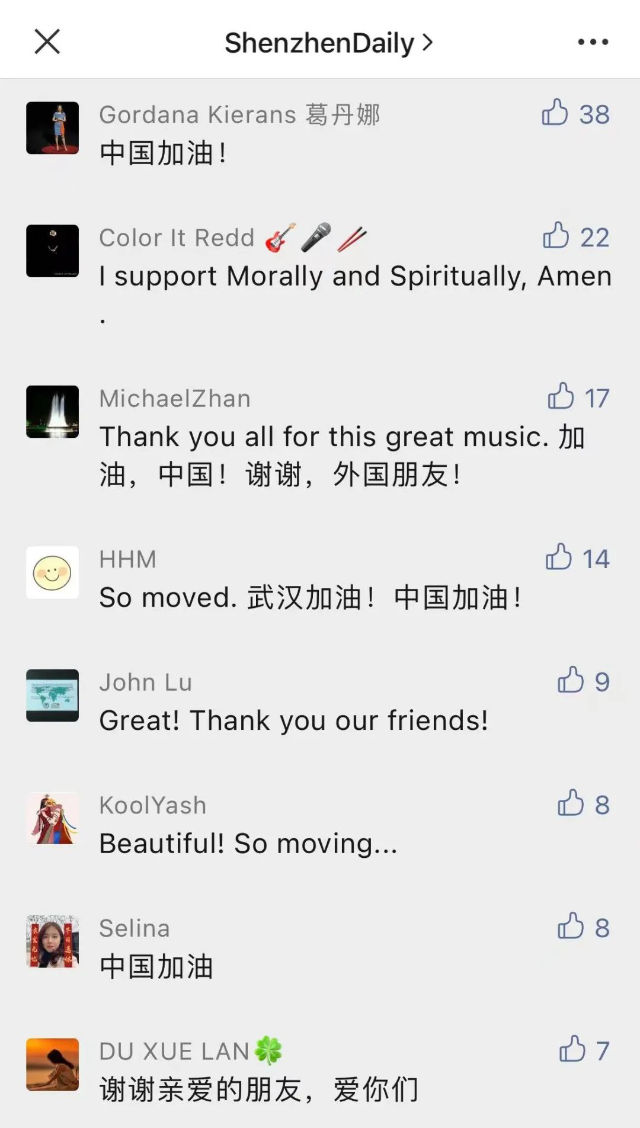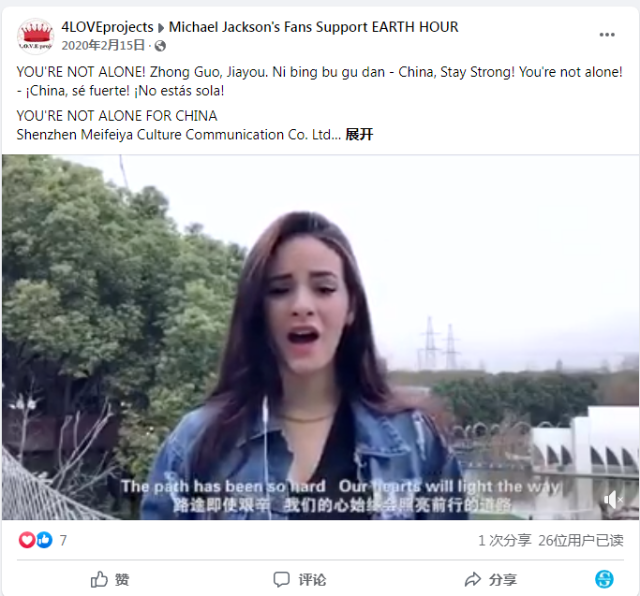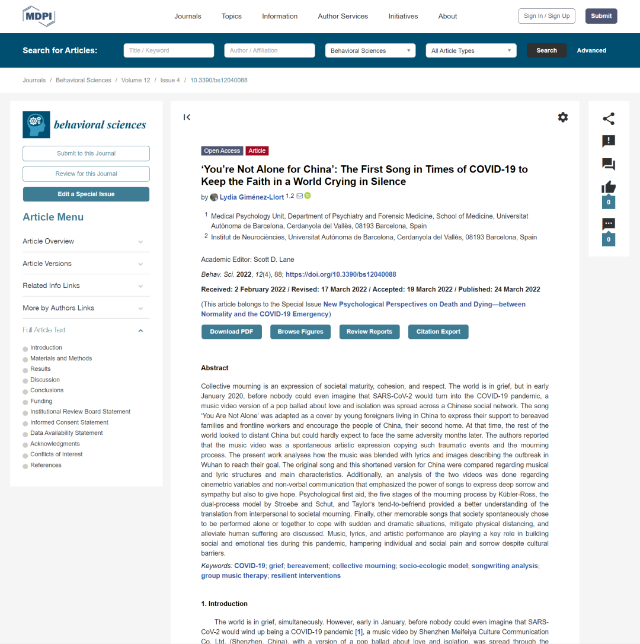The music video “You Are Not Alone for China.”
Lydia Giménez-Llort, a professor of psychiatry at the Autonomous University of Barcelona in Spain, has recently written to Shenzhen Daily, saying she has scientifically analyzed the music video “You’re Not Alone for China,” which was first reported by Shenzhen Daily in February 2020 when the pandemic just began.
The paper was published on the official website of Multidisciplinary Digital Publishing Institute (https://www.mdpi.com/2076-328X/12/4/88) on March 24, 2022.In early 2020, dozens of expat musicians living and working across China collaborated to make the heartwarming music video and released it Feb. 9, 2020, to support China, their second home, in the fight against the epidemic. All the expat musicians worked for the same company, Shenzhen Meifeiya Culture Communication Co. Ltd. The song was adapted from Michael Jackson’s classic hit “You Are Not Alone.”On Feb. 9, the same day the musicians released the music video, Shenzhen Daily spread the music video under the title “Expat musicians: China, You Are Not Alone” on its official WeChat account. On Feb. 11, Shenzhen Daily published a report titled “Expats present heart-touching music video to support China,” on its WeChat account as well as on the EyeShenzhen website, which Giménez-Llort used as a reference for her paper.The music video, which pulled on the heartstrings of many people in communities in China and abroad, went viral on different social media platforms.
Comments below the video published on Shenzhen Daily official WeChat account.Giménez-Llort’s paper titled “’You’re Not Alone for China’: The First Song in Times of COVID-19 to Keep the Faith in a World Crying in Silence,” analyzed the music video in terms of the human mourning process during the COVID-19 pandemic, contributing to our understanding of associated traumas, and most importantly, the resilience shown by those who are in the video.Screenshots of the publication of Lydia Giménez-Llort's paper that analyzes the music video “You’re Not Alone for China.”
Giménez-Llort, whose bond with China dates back to the 1990s, is a big fan of Michael Jackson. “I was the chief of assistants for China and other three Asian Paralympic Barcelona 1992 delegations, spent my August in 1993 traveling along China to visit ‘my athletes, my Chinese paralympic family,’ and founded the ‘Friends for China’ in Barcelona,” Giménez-Llort said in a recent interview with Shenzhen Daily.In early 2020, someone shared with Giménez-Llort the music video on WhatsApp. At the beginning, she thought it was because people knew she was a fan of the renowned American singer and her bond with China, but after a few seconds of watching the video, when she saw a car entering an empty highway and the first verses “Another day has gone, Our hope can make us strong,” she realized the video was talking about the new epidemic in Wuhan.“I felt overwhelmed. I could feel the singers’ sorrow, in their facial expressions, in their eyes, in their voices, and the scenes of the streets, the ambulances, the frontline workers, the building of a new hospital... everything made me feel like being part of it. But I could also feel the strength and the hope, the unity of people, the children encouraging adults,” said Giménez-Llort.The professor, deeply touched by the video, immediately organized a Facebook event at the “4LOVEprojects” account Feb. 15, 2020.
A screenshot of the Facebook event at the "4LOVEprojects" account Feb. 15, 2020.“The video was so real, sincere, sharing feelings and describing the extreme situation they were confronting, expressing support and hope,” Giménez-Llort added.According to her, the song has several features that make it touching. The first and most important features are the song’s lyrics, music and images evoking feelings of being understood and identified. “Our social brain gives us the extraordinary capacity to feel the pain and sorrow of another individual. Conversely, to feel some relief when others know about our situation and comprehend our suffering to the extent to feel it, too.”Another feature is that the original song is already a ballad, a musical structure that is highly emotional and a lyric that asks questions and gives answers. “So, it is perfect to talk about problems and painful experiences where uncertainty and sadness dominate the story,” Giménez-Llort said.She said the pandemic has caused psychological problems due to different reasons and the song led to a catharsis for most people. “We are like sparkling water in a bottle that is shaken and the song, the music opens the tap to release all the pressure.”The musicians who are in the video all felt excited knowing that their music video was scientifically chosen and analyzed.“I feel very honored. I wasn’t really aware of the connotation and importance of this song. This analysis was indeed accurate. It explained perfectly what I felt at the moment I wrote those lyrics. I didn’t even remember the feeling until I read the article,” said Citara from Cuba, who adapted the lyrics and was one of the music video’s lead singers.“When I learned that the song was selected for scientific research, I was surprised because it has been two years since, and it was done during the peak of China’s fight against the epidemic back then, with the aim of supporting and carrying a positive message in such difficult times. We never imagined or expected that something like this happened all this time,” said Yimmy Parra Morales from Cuba, who played the guitar and sang the chorus with his wife, who was his girlfriend at the time the video was made.Another Cuban expat, Daymara Viñals Acosta, who is currently back in Cuba due to the pandemic, said it’s very exciting that two years after the video was made, someone dedicated her time to analyze it.














